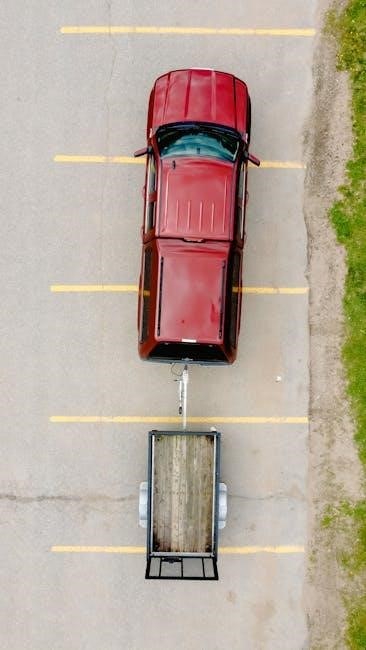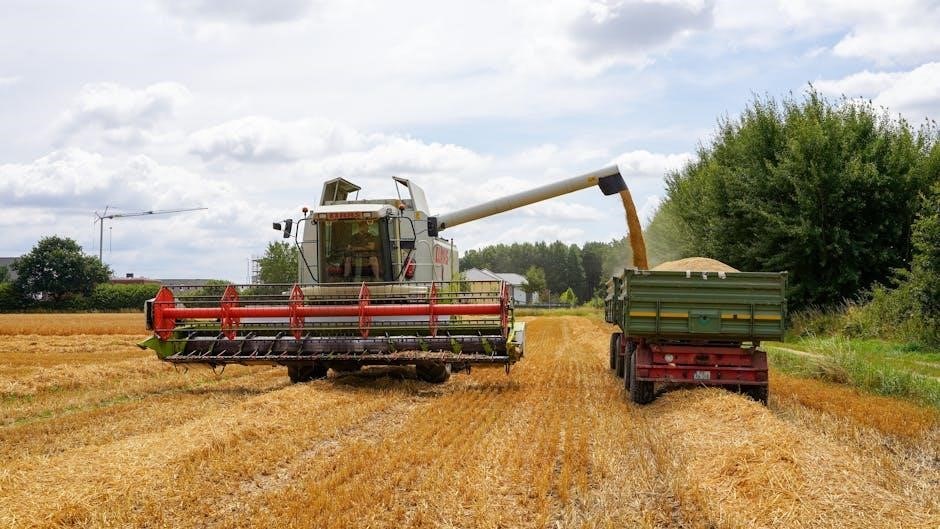A comprehensive guide to understanding trailer hitches, their importance, and proper installation․ Learn how to choose the right hitch for your vehicle, ensuring safety and efficiency while towing․
What is a Trailer Hitch?
A trailer hitch is a hardware component attached to a vehicle’s frame, enabling it to tow trailers, boats, or other equipment․ It acts as a connection point, transferring weight and force safely․ Hitches come in various types, such as receiver, gooseneck, and fifth wheel, each designed for specific towing needs․ Proper installation ensures stability and control, making it essential for secure and efficient towing․ A well-chosen hitch enhances safety, prevents damage, and maximizes towing capacity, adapting to different vehicle and trailer configurations․
Importance of Using the Right Trailer Hitch
Using the correct trailer hitch is crucial for ensuring safety, stability, and optimal towing performance․ A properly matched hitch prevents excessive wear on your vehicle and trailer, reducing the risk of damage or detachment while towing․ It also enhances control and maneuverability, minimizing the likelihood of swaying or loss of control․ Choosing the right hitch tailored to your vehicle and trailer specifications ensures a secure connection, protecting both your investment and the safety of everyone on the road․ This attention to detail is vital for a reliable and stress-free towing experience․
Key Components of a Trailer Hitch System
A trailer hitch system consists of several essential components, each playing a critical role in safe and efficient towing․ The receiver hitch is the primary attachment point, mounted to the vehicle’s frame․ Inside it sits the ball mount, which holds the hitch ball that connects to the trailer․ The wiring harness ensures proper communication between the vehicle and trailer lights․ Additional components like weight distribution hitches and safety chains enhance stability and security․ Together, these parts form a robust system designed to handle the demands of towing various trailers safely and effectively․

Types of Trailer Hitches
Explore the various types of trailer hitches available, including receiver, gooseneck, fifth wheel, bumper, and weight distribution hitches, each designed for specific towing needs and vehicle compatibility․
Receiver Hitches
Receiver hitches are the most common type, featuring a square or rectangular receiver tube․ They are bolted to the vehicle’s frame and accept various hitch accessories․ Lightweight trailers, bike racks, and cargo carriers often use Class I or II receivers, while heavier trailers require Class III or IV․ Installation typically involves attaching to the vehicle’s frame, with no inner components needed․ They are versatile, cost-effective, and widely available․ Proper installation ensures safety and durability, making them ideal for everyday towing needs and vehicle compatibility across many models․
Gooseneck Hitches
Gooseneck hitches are designed for heavy-duty towing, ideal for large trailers like RVs or horse trailers․ Installed in the truck bed above the rear axle, they provide exceptional strength and stability․ These hitches use a ball-and-coupler system, offering better control and reducing trailer sway․ They are suitable for heavy loads and frequent use, making them a popular choice for professionals․ Installation may require professional assistance due to their complexity․ Gooseneck hitches are a reliable option for those needing to tow substantial weights safely and efficiently, ensuring durability and performance for heavy-duty applications․
Fifth Wheel Hitches
Fifth wheel hitches are designed for heavy-duty towing, typically used with large trailers like RVs or heavy equipment․ Installed in the bed of a pickup truck, they provide exceptional stability and weight distribution․ The hitch features a large coupling surface that accommodates the trailer’s kingpin, offering superior control and minimizing trailer sway․ With high weight capacities, these hitches are ideal for serious towing needs․ Installation often requires a mounting system in the truck bed, and while some models are removable, professional installation is recommended for safety and proper function․ Fifth wheel hitches are a top choice for those requiring reliable, high-capacity towing solutions․
Bumper Hitches
Bumper hitches are simple, cost-effective towing solutions mounted directly to a vehicle’s bumper․ They are ideal for light to medium towing needs, such as small boats, utility trailers, or campers․ These hitches are easy to install and require no additional frames or welding․ With weight capacities typically ranging from 3,500 to 10,000 pounds, they suit casual towing scenarios․ Bumper hitches are a practical choice for drivers seeking a no-frills option for occasional use․ However, they may not offer the stability or weight distribution of more advanced hitch systems, limiting their suitability for heavy-duty applications or large trailers․
Weight Distribution Hitches
Weight distribution hitches enhance towing stability by redistributing the trailer’s weight evenly between the tow vehicle and trailer axles․ They reduce sway and improve control, especially for larger trailers․ These hitches use spring bars and a unique coupling system to balance the load, preventing the rear of the tow vehicle from sagging․ Ideal for heavy-duty towing, they ensure a smoother ride and better braking performance․ Weight distribution hitches are essential for maintaining safety and stability when towing heavy loads, making them a top choice for experienced towers and professionals․

Determining Your Vehicle’s Towing Capacity
Your vehicle’s towing capacity is crucial for safe and efficient towing․ It depends on factors like engine power, axle ratio, and vehicle weight distribution․
Understanding Towing Capacity Ratings
Towing capacity ratings indicate the maximum weight your vehicle can safely pull․ These ratings are determined by factors like engine power, axle ratio, and vehicle weight distribution․ Always refer to your vehicle’s manual or manufacturer specifications to find the exact towing capacity․ Exceeding this limit can lead to poor vehicle performance, increased risk of accidents, and potential damage to your vehicle and trailer․ Properly matching your trailer’s weight with your vehicle’s capacity ensures a safe and controlled towing experience․ Never rely on estimates; use precise calculations for optimal safety․
How to Find Your Vehicle’s Towing Limits
To determine your vehicle’s towing limits, consult the owner’s manual or the manufacturer’s specifications․ The Gross Vehicle Weight Rating (GVWR) and Gross Trailer Weight Rating (GTWR) are typically listed on a placard inside the driver’s door or fuel filler door․ These ratings provide the maximum weight your vehicle can safely tow․ Additionally, refer to the hitch manufacturer’s guidelines, as they may impose further restrictions․ Always follow the lowest rated capacity among your vehicle, hitch, and trailer to ensure safe towing conditions and avoid potential damage or hazards on the road․
Factors Affecting Towing Capacity
Several factors influence your vehicle’s towing capacity, including engine type, axle ratio, and vehicle weight distribution․ The trailer’s weight and balance also play a crucial role․ Proper trailer hitch installation and the use of weight distribution systems can enhance towing stability․ Additionally, environmental conditions like inclines and wind resistance can impact towing performance․ Always consider the vehicle manufacturer’s specifications and the hitch’s rated capacity to ensure safe and efficient towing․ Neglecting these factors can lead to reduced control, potential damage, or safety hazards while towing․

Choosing the Right Trailer Hitch for Your Vehicle
Selecting the right trailer hitch for your vehicle is crucial for safe and efficient towing․ Consider vehicle-specific options, custom-fit vs universal, and your towing frequency and trailer type․
Vehicle-Specific Hitch Options
Vehicle-specific hitches are tailored to your car’s make and model, ensuring a precise fit․ They often come with pre-drilled holes for easy installation and are designed to maximize your vehicle’s towing capacity․ These hitches are typically more durable and provide a seamless integration with your car’s frame․ Many manufacturers offer custom-fit options, which eliminate the need for modifications․ By choosing a vehicle-specific hitch, you ensure optimal performance, safety, and compatibility, making towing easier and more efficient․ This is a wise choice for those prioritizing convenience and reliability․
Custom-Fit vs․ Universal Hitches
Custom-fit hitches are designed specifically for your vehicle’s make and model, ensuring a seamless installation and optimal performance․ They often require no drilling and are tailored to your car’s frame․ Universal hitches, on the other hand, are more versatile and can fit multiple vehicles but may need adjustments․ Custom-fit options are ideal for those seeking convenience and a perfect match, while universal hitches offer flexibility for owners with multiple vehicles․ Both types ensure safety and durability, but the choice depends on your towing needs and preferences․
Considering Towing Frequency and Trailer Type
Choosing the right hitch depends on how often you tow and the type of trailer you use․ Frequent towing demands a sturdy, heavy-duty hitch, while occasional use may suffice with a lighter option․ Trailers like campers, boats, or livestock carriers have specific needs, requiring hitches designed for their weight and shape․ Mismatching can lead to instability or damage, so understanding your towing habits and trailer requirements is crucial․ Always assess these factors to ensure safe, efficient, and reliable towing performance tailored to your lifestyle and needs․

Safety Considerations for Towing
Ensure a secure connection, proper weight distribution, and regular hitch inspections․ Always use safety chains and consult your vehicle’s towing capacity to avoid accidents and damage․
Proper Hitch Installation and Maintenance
Correct installation ensures safety and durability․ Follow manufacturer instructions, tighten bolts securely, and inspect regularly for wear․ Lubricate moving parts and replace worn components promptly․ Regular maintenance prevents failures․
Weight Distribution and Trailer Balance
Proper weight distribution is crucial for safe towing․ A weight distribution hitch helps evenly distribute the trailer’s weight, improving stability and control; Ensure the trailer is balanced, with 10-15% of its weight on the tongue․ Incorrect distribution can lead to swaying or loss of control․ Regularly check the hitch setup and adjust as needed․ Proper balance ensures smooth towing and prevents potential hazards on the road․ Always follow manufacturer guidelines for optimal weight distribution and trailer balance to maximize safety and performance during towing․
Essential Safety Accessories
Ensure towing safety with key accessories like hitch locks, trailer wiring harnesses, and sway control devices․ Hitch locks prevent theft and unauthorized detachment, while trailer wiring ensures proper brake and lighting functions․ Sway control devices enhance stability, reducing trailer movement; Safety chains and emergency breakaway kits are also critical for emergencies․ Regularly inspect these components to maintain reliability․ Properly secured and functioning accessories are vital for safe towing experiences, protecting both the vehicle and trailer during transit․ Always prioritize high-quality, durable accessories to complement your trailer hitch system․

Installing a Trailer Hitch
Installing a trailer hitch involves measuring, drilling, and securing the hitch to your vehicle’s frame․ Use high-strength bolts and ensure proper alignment for safe towing․ Always consult a professional if unsure․
DIY Hitch Installation Steps
Start by gathering tools and ensuring your vehicle is on level ground․ Measure the frame to determine hitch placement, marking drill holes accurately․ Use a drill bit to create pilot holes, then enlarge them as needed․ Secure the hitch with high-strength bolts, tightening evenly․ Double-check alignment and clearance․ Finally, test the hitch by attaching a trailer, ensuring stability and proper weight distribution․ Always follow the manufacturer’s instructions and consider professional help if unsure․
When to Hire a Professional
If you lack experience or tools, hiring a professional is wise․ They ensure proper installation, safety, and compliance with vehicle specifications․ Complex setups, like weight distribution hitches, often require expert knowledge․ Professionals handle welding and frame modifications, minimizing risks of damage or liability․ They also provide warranties and post-installation checks, ensuring everything functions correctly․ Save time and reduce stress by letting skilled technicians handle the job, especially for heavy-duty towing needs or unique vehicle configurations․
Post-Installation Checks
After installing a trailer hitch, perform a thorough inspection to ensure safety and reliability․ Check all bolts and nuts for tightness, verifying torque specifications․ Inspect the hitch for proper alignment with the vehicle frame and trailer․ Test the electrical connections to confirm proper function of lights and brakes․ Ensure the hitch ball is securely attached and the coupler fits correctly․ Finally, conduct a small test tow to assess handling and stability․ These steps ensure your setup is safe and ready for towing, preventing potential issues on the road․

Trailer Hitch Accessories
Enhance your towing experience with essential accessories like ball mounts, hitch balls, trailer wiring, and locks․ These components ensure secure, safe, and efficient trailer connections and operations․
Ball Mounts and Hitch Balls
Ball mounts and hitch balls are essential for securing your trailer to the hitch․ They come in various sizes to accommodate different trailer couplers, ensuring a snug fit․ Proper installation and alignment are critical for safety․ The ball mount is typically attached to the hitch receiver, while the hitch ball connects to the trailer coupler․ Always match the ball size to the trailer’s coupler for optimal performance․ Regularly inspect these components for wear or damage to prevent failure․ Choosing the right materials, like chrome or stainless steel, can enhance durability and corrosion resistance․ Proper tightening ensures a secure connection during towing․
Trailer Wiring and Connectors
Trailer wiring and connectors are vital for ensuring proper communication between your vehicle and trailer․ They power essential functions like brakes, turn signals, and running lights․ Incorrect wiring can lead to safety hazards, so it’s crucial to use the right connectors and ensure they are securely attached․ Regularly inspect wiring for damage or corrosion, and replace worn-out connectors to maintain reliability․ Many vehicles come with factory-installed wiring harnesses, while others may require aftermarket solutions․ Proper installation ensures seamless operation and compliance with safety standards, making towing safer and more efficient for all drivers․ Always match connector types to your vehicle and trailer specifications․
Locks and Security Devices
Locks and security devices are essential for protecting your trailer hitch and trailer from theft․ Hitch locks prevent unauthorized detachment, while coupler locks secure the trailer to the hitch․ Cable locks add an extra layer of protection by connecting the trailer to your vehicle or a fixed object․ These devices ensure your equipment remains safe, especially when left unattended․ Choose high-quality, durable locks designed for your specific hitch type․ Regularly inspect locks for wear and ensure they are securely fastened․ Proper use of locks and security devices provides peace of mind and safeguards your investment against potential theft or tampering․

Maintenance and Troubleshooting
Regularly inspect hitch components for wear, lubricate moving parts, and address rust․ Promptly fix issues to ensure reliability and safety while towing․
Regular Maintenance Tips

Regular maintenance is crucial for ensuring the longevity and reliability of your trailer hitch․ Start by inspecting all components for signs of wear, rust, or damage․ Clean and lubricate moving parts, such as the hitch ball and coupler, to prevent corrosion and ensure smooth operation․ Check the tightness of all bolts and nuts, especially after initial installation․ Additionally, verify that the hitch is properly aligned with the trailer coupler before each use․ Finally, apply a rust-inhibiting coating to metal parts to protect against environmental damage․ These practices help prevent issues and ensure safe towing experiences․
Common Issues and Solutions
Common trailer hitch issues include rust, loose bolts, and uneven weight distribution․ To address rust, clean and apply a rust-inhibiting coating․ For loose bolts, tighten them regularly and consider using lock nuts․ Uneven weight distribution can be resolved with a weight distribution hitch․ Misalignment during hook-up can be fixed by ensuring proper positioning and lubricating moving parts․ Addressing these issues promptly prevents safety hazards and extends the hitch’s lifespan, ensuring reliable performance for all towing needs․
When to Replace Hitch Components
Replace hitch components when you notice excessive wear, rust, or damage․ If bolts are stripped or components show signs of fatigue, replacement is essential for safety․ Rust that weakens structural integrity requires immediate attention․ Additionally, if your hitch exceeds the manufacturer’s recommended lifespan or towing capacity, it’s time to replace it․ Damaged or bent parts should never be reused, as they compromise towing stability․ Regular inspections can help identify worn-out elements early․ Always prioritize safety and performance by replacing components promptly to avoid towing accidents or equipment failure․

Advanced Features in Modern Trailer Hitches
Modern trailer hitches feature innovative technologies like Hitch Guidance Systems, Weight Distribution Technology, and Integrated Camera and Sensor Systems to enhance towing safety and efficiency․
Hitch Guidance Systems
Hitch Guidance Systems use cameras and sensors to assist drivers in aligning their vehicle’s hitch with the trailer․ These systems display guidelines on the Rear Vision Camera, making the process easier and reducing the need for trial and error․ They enhance precision, especially for inexperienced drivers, and improve safety by minimizing the risk of accidents during hookup․ Advanced models may offer real-time feedback, ensuring a secure connection every time․ This technology is particularly useful for larger vehicles or in tight spaces․
Weight Distribution Technology
Weight distribution technology enhances towing stability by evenly distributing the trailer’s weight across the tow vehicle and trailer axles․ This system uses specialized components like spring bars and sway control to prevent trailer sway and improve handling․ By redistributing the weight, it reduces the risk of fishtailing and enhances overall control, especially at higher speeds․ This technology is crucial for heavier trailers, ensuring a smoother and safer towing experience․ Proper setup is essential to maximize its benefits and maintain optimal vehicle performance during towing operations․
Integrated Camera and Sensor Systems
Modern trailer hitches often feature integrated camera and sensor systems to enhance towing safety and convenience․ These systems provide real-time feedback, helping drivers align the hitch and trailer accurately․ Rear Vision Cameras with Hitch View display guidelines to simplify hookups, while sensors monitor the trailer’s position and detect potential issues․ Advanced systems can even alert drivers to trailer sway or uneven weight distribution․ These technologies reduce the risk of accidents and make towing more manageable, especially for inexperienced users․ They represent a significant advancement in towing safety and ease of use, integrating seamlessly with vehicle electronics for a smoother experience․
With this guide, you now have the knowledge to confidently choose, install, and maintain the right trailer hitch for safe and effective towing experiences․ Happy adventuring!
Final Tips for Safe and Effective Towing
- Always ensure your trailer is properly balanced, with 10-15% of its weight on the tow vehicle․
- Regularly inspect hitch components, wiring, and tires for wear or damage․
- Never exceed your vehicle’s towing capacity, as specified in the owner’s manual․
- Use weight distribution hitches for heavier loads to maintain stability․
- Invest in essential accessories like trailer locks and sway control devices․
- Practice hitching and unhitching in a safe, open area to build confidence․
- Consider modern features like hitch guidance systems for easier alignment․
- Consult a professional if unsure about installation or compatibility․
Resources for Further Learning
For deeper insights, explore online guides like the Select-A-Hitch Guide and Rack Attack for expert advice․ Manufacturer websites, such as Curt and Reese, offer detailed installation manuals and product specifications․ Online forums and communities, like truck enthusiast groups, provide real-world experiences and troubleshooting tips․ Additionally, consult your vehicle’s owner’s manual for specific towing recommendations․ Local auto shops and towing specialists can also offer personalized guidance․ These resources will help you make informed decisions and enhance your towing experience․

